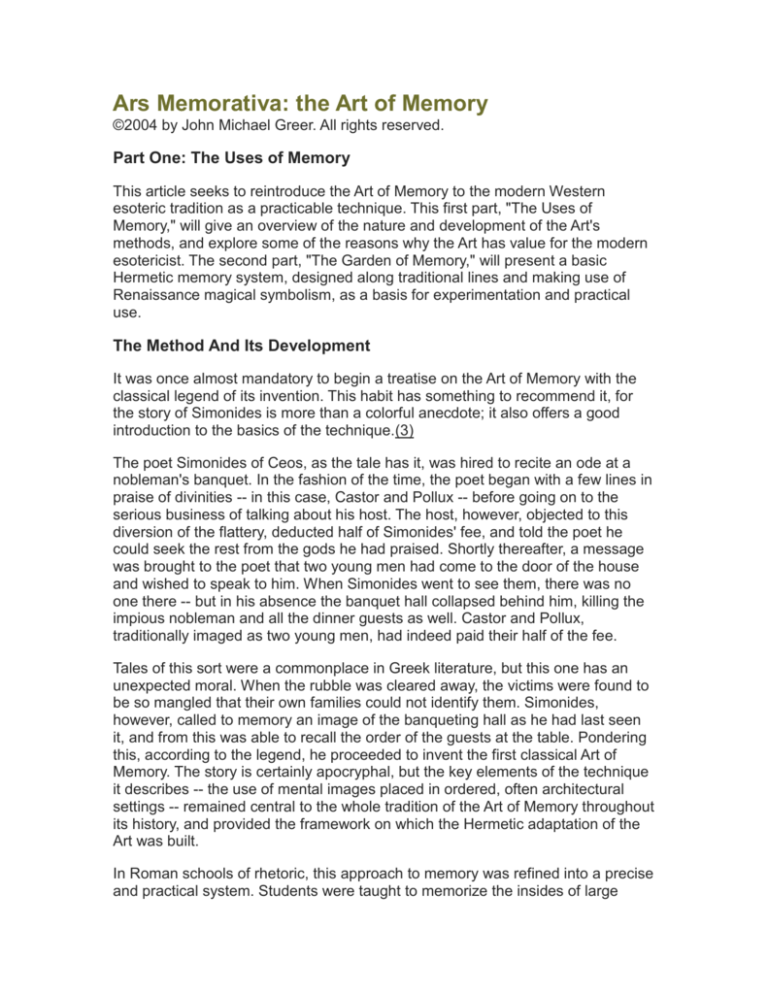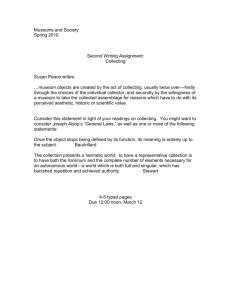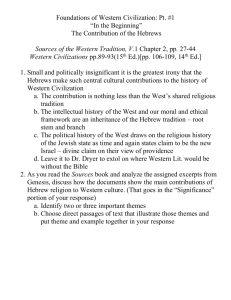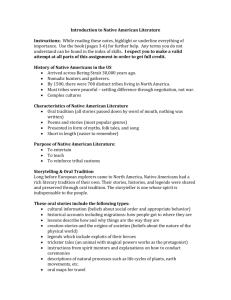
Ars Memorativa: the Art of Memory
©2004 by John Michael Greer. All rights reserved.
Part One: The Uses of Memory
This article seeks to reintroduce the Art of Memory to the modern Western
esoteric tradition as a practicable technique. This first part, "The Uses of
Memory," will give an overview of the nature and development of the Art's
methods, and explore some of the reasons why the Art has value for the modern
esotericist. The second part, "The Garden of Memory," will present a basic
Hermetic memory system, designed along traditional lines and making use of
Renaissance magical symbolism, as a basis for experimentation and practical
use.
The Method And Its Development
It was once almost mandatory to begin a treatise on the Art of Memory with the
classical legend of its invention. This habit has something to recommend it, for
the story of Simonides is more than a colorful anecdote; it also offers a good
introduction to the basics of the technique.(3)
The poet Simonides of Ceos, as the tale has it, was hired to recite an ode at a
nobleman's banquet. In the fashion of the time, the poet began with a few lines in
praise of divinities -- in this case, Castor and Pollux -- before going on to the
serious business of talking about his host. The host, however, objected to this
diversion of the flattery, deducted half of Simonides' fee, and told the poet he
could seek the rest from the gods he had praised. Shortly thereafter, a message
was brought to the poet that two young men had come to the door of the house
and wished to speak to him. When Simonides went to see them, there was no
one there -- but in his absence the banquet hall collapsed behind him, killing the
impious nobleman and all the dinner guests as well. Castor and Pollux,
traditionally imaged as two young men, had indeed paid their half of the fee.
Tales of this sort were a commonplace in Greek literature, but this one has an
unexpected moral. When the rubble was cleared away, the victims were found to
be so mangled that their own families could not identify them. Simonides,
however, called to memory an image of the banqueting hall as he had last seen
it, and from this was able to recall the order of the guests at the table. Pondering
this, according to the legend, he proceeded to invent the first classical Art of
Memory. The story is certainly apocryphal, but the key elements of the technique
it describes -- the use of mental images placed in ordered, often architectural
settings -- remained central to the whole tradition of the Art of Memory throughout
its history, and provided the framework on which the Hermetic adaptation of the
Art was built.
In Roman schools of rhetoric, this approach to memory was refined into a precise
and practical system. Students were taught to memorize the insides of large
buildings according to certain rules, dividing the space into specific loci or
"places" and marking every fifth and tenth locus with special signs. Facts to be
remembered were converted into striking visual images and placed, one after
another, in these loci; when needed, the rhetorician needed only to stroll in his
imagination through the same building, noticing the images in order and recalling
their meanings. At a more advanced level, images could be created for individual
words or sentences, so that large passages of text could be stored in the
memory in the same way. Roman rhetoricians using these methods reached
dizzying levels of mnemonic skill; one famous practitioner of the Art was recorded
to have sat through a day-long auction and, at its end, repeated from memory the
item, purchaser and price for every sale of the day.
With the disintegration of the Roman world, these same techniques became part
of the classical heritage of Christianity. The Art of Memory took on a moral cast
as memory itself was defined as a part of the virtue of prudence, and in this guise
the Art came to be cultivated by the Dominican Order. It was from this source that
the ex-Dominican Giordano Bruno (1548-1600), probably the Art's greatest
exponent, drew the basis of his own techniques. (4)
Medieval methods of the Art differed very little from those of the classical world,
but certain changes in the late Middle Ages helped lay the foundations for the
Hermetic Art of Memory of the Renaissance. One of the most important of these
was a change in the frameworks used for memory loci. Along with the
architectural settings most often used in the classical tradition, medieval
mnemonists also came to make use of the whole Ptolemaic cosmos of nested
spheres as a setting for memory images. Each sphere from God at the periphery
through the angelic, celestial and elemental levels down to Hell at the center thus
held one or more loci for memory images.
Between this system and that of the Renaissance Hermeticists there is only one
significant difference, and that is a matter of interpretation, not of technique.
Steeped in Neoplatonic thought, the Hermeticists of the Renaissance saw the
universe as an image of the divine Ideas, and the individual human being as an
image of the universe; they also knew Plato's claim that all "learning" is simply
the recollection of things known before birth into the realm of matter. Taken
together, these ideas raised the Art of Memory to a new dignity. If the human
memory could be reorganized in the image of the universe, in this view, it
became a reflection of the entire realm of Ideas in their fullness -- and thus the
key to universal knowledge. This concept was the driving force behind the
complex systems of memory created by several Renaissance Hermeticists, and
above all those of Giordano Bruno.
Bruno's mnemonic systems form, to a great extent, the high-water mark of the
Hermetic Art of Memory. His methods were dizzyingly complex, and involve a
combination of images, ideas and alphabets, which require a great deal of
mnemonic skill to learn in the first place! Hermetic philosophy and the traditional
images of astrological magic appear constantly in his work, linking the framework
of his Art to the wider framework of the cosmos.....
Bruno's alphabet included thirty letters, the Latin alphabet plus those Greek and
Hebrew letters which have no Latin equivalents; his system thus allowed texts
written in any of these alphabets to be memorized. He combined these with five
vowels, and provided additional images for single letters to allow for more
complex combinations. Besides the astrological images and inventors, there are
also lists of objects and adjectives corresponding to this set of lettercombinations, and all these can be combined in a single memory-image to
represent words of several syllables. At the same time, many of the images stand
for ideas as well as sounds.
Bruno's influence can be traced in nearly every subsequent Hermetic memory
treatise, but his own methods seem to have proved too demanding for many.
Records suggest that his mnemonics, passed on by his student Alexander
Dicson, may have been taught in Scots Masonic lodges in the sixteenth
century;(7) more common, though, were methods like the one diagrammed by
the Hermetic encyclopedist Robert Fludd in his History of the Macrocosm and
Microcosm. This was a fairly straightforward adaptation of the late Medieval
method, using the spheres of the heavens as loci, although Fludd nonetheless
classified it along with prophecy, geomancy and astrology as a "microcosmic art"
of human self-knowledge.8 Both his approach to the Art and his classification of it
remained standard in esoteric circles until the triumph of Cartesian mechanism in
the late seventeenth century sent the Hermetic tradition underground and the Art
of Memory into oblivion.
The Method And Its Value
This profusion of techniques begs two questions, which have to be answered if
the Art of Memory is to be restored to a place in the Western esoteric tradition.
First of all, are the methods of the Art actually superior to rote memorization as a
way of storing information in the human memory? Put more plainly, does the Art
of Memory work?
It's fair to point out that this has been a subject of dispute since ancient times.
Still, then as now, those who dispute the Art's effectiveness are generally those
who have never tried it. In point of fact, the Art does work; it allows information to
be memorized and recalled more reliably, and in far greater quantity, than rotemethods do. There are good reasons, founded in the nature of memory, why this
should be so. The human mind recalls images more easily than ideas, and
images charged with emotion more easily still; one's most intense memories, for
example, are rarely abstract ideas. It uses chains of association, rather than
logical order, to connect one memory with another; simple mnemonic tricks like
the loop of string tied around a finger rely on this. It habitually follows rhythms
and repetitive formulae; it's for this reason that poetry is often far easier to
remember than prose. The Art of Memory uses all three of these factors
systematically. It constructs vivid, arresting images as anchors for chains of
association, and places these in the ordered and repetitive context of an
imagined building or symbolic structure in which each image and each locus
leads on automatically to the next. The result, given training and practice, is a
memory which works in harmony with its own innate strengths to make the most
of its potential.
The fact that something can be done, however, does not by itself prove that it
should be done. In a time when digital data storage bids fair to render print media
obsolete, in particular, questions of how best to memorize information might well
seem as relevant as the choice between different ways of making clay tablets for
writing. Certainly some methods of doing this once-vital chore are better than
others; so what? This way of thinking leads to the second question a revival of
the Art of Memory must face: what is the value of this sort of technique?
This question is particularly forceful in our present culture because that culture,
and its technology, have consistently tended to neglect innate human capacities
and replace them where possible with mechanical equivalents. It would not be
going too far to see the whole body of modern Western technology as a system
of prosthetics. In this system, print and digital media serve as a prosthetic
memory, doing much of the work once done in older societies by the trained
minds of mnemonists. It needs to be recognized, too, that these media can
handle volumes of information which dwarf the capacity of the human mind; no
conceivable Art of Memory can hold as much information as a medium-sized
public library.
The practical value of these ways of storing knowledge, like that of much of our
prosthetic technology, is real. At the same time, there is another side to the
matter, a side specially relevant to the Hermetic tradition. Any technique has
effects on those who use it, and those effects need not be positive ones.
Reliance on prosthetics tends to weaken natural abilities; one who uses a car to
travel anywhere more than two blocks away will come to find even modest walks
difficult. The same is equally true of the capacities of the mind. In Islamic
countries, for example, it's not at all uncommon to find people who have
memorized the entire Quran for devotional purposes. Leave aside, for the
moment, questions of value; how many people in the modern West would be
capable of doing the equivalent?
One goal of the Hermetic tradition, by contrast, is to maximize human capacities,
as tools for the inner transformations sought by the Hermeticist. Many of the
elementary practices of that tradition -- and the same is true of esoteric systems
worldwide -- might best be seen as a kind of mental calisthenics, intended to
stretch minds grown stiff from disuse. This quest to expand the powers of the self
stands in opposition to the prosthetic culture of the modern West, which has
consistently tended to transfer power from the self to the exterior world. The
difference between these two viewpoints has a wide range of implications -philosophical, religious, and (not the least) political -- but the place of the Art of
Memory can be found among them.
From what might be called the prosthetic standpoint, the Art is obsolete because
it is less efficient than external data-storage methods such as books, and
distasteful because it requires the slow development of inner abilities rather than
the purchase of a piece of machinery. From a Hermetic standpoint, on the other
hand, the Art is valuable in the first place as a means of developing one of the
capacities of the self, the memory, and in the second place because it uses other
capacities -- attention, imagination, mental imagery -- which have a large role in
other aspects of Hermetic practice.
Like other methods of self-development, the Art of Memory also brings about
changes in the nature of the capacity it shapes, not merely in that capacity's
efficiency or volume; its effects are qualitative as well as quantitative -- another
issue not well addressed by the prosthetic approach. Ordinarily, memory tends to
be more or less opaque to consciousness. A misplaced memory vanishes from
sight, and any amount of random fishing around may be needed before an
associative chain leading to it can be brought up from the depths. In a memory
trained by the methods of the Art, by contrast, the chains of association are
always in place, and anything memorized by the Art can thus be found as soon
as needed. Equally, it's much easier for the mnemonist to determine what exactly
he or she does and does not know, to make connections between different points
of knowledge, or to generalize from a set of specific memories; what is stored
through the Art of Memory can be reviewed at will.
Despite our culture's distaste for memorization, and for the development of the
mind generally, the Art of Memory thus has some claim to practical value, even
beyond its uses as a method of esoteric training
Notes
1. Yates, Frances A., The Art Of Memory (Chicago: U. Chicago Press,1966)
remains the standard English-language work on the tradition.
2. Bruno, Giordano, On the Composition of Images, Signs and Ideas (NY: Willis,
Locker & Owens, 1991), and Culianu, Ioan, Eros and Magic in the Renaissance
(Chicago: U. Chicago Press, 1987) are examples.
3. The brief history of the Art given here is drawn from Yates, op. cit.
4. For Bruno, see Yates, op. cit., ch. 9, 11, 13-14, as well as her Giordano Bruno
and the Hermetic Tradition (Chicago: U. Chicago Press, 1964).
5. See Yates, Art of Memory, Ch. 8.
6. Ibid., pp. 208-222.
7. Stevenson, David, The Origins of Freemasonry: Scotland's Century
(Cambridge: Cambridge U.P., 1988), p. 95.
8. See Yates, Art of Memory, Ch. 15.










